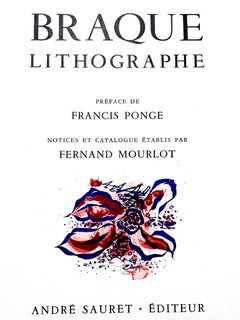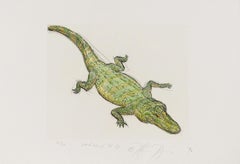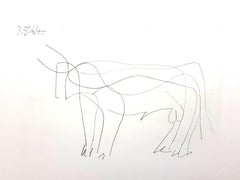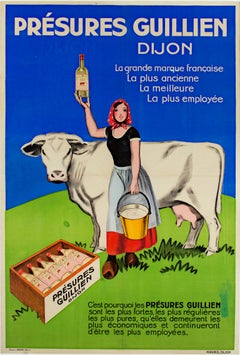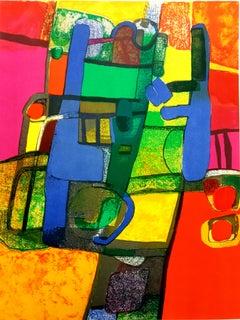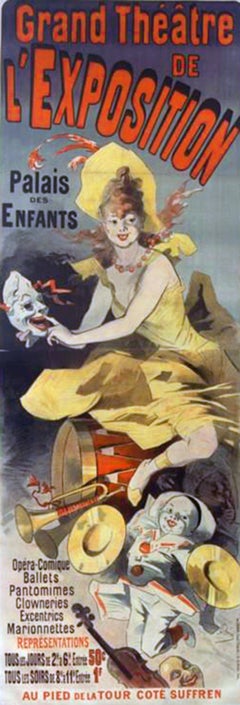Lithograph Animal Prints
to
76
622
53
61
38
10
Overall Width
to
Overall Height
to
784
276
166
96
74
63
28
24
21
4
2
2
1
1
77
22
16
12
8
479
303
2
1
7
2
11
39
31
50
102
9
4
426
343
15
382
281
228
179
131
86
77
70
70
67
54
53
47
39
38
37
37
33
32
31
784
698
348
272
66
35
347
176
157
Style: Modern
Medium: Lithograph
Georges Braque - Original Lithograph
Located in Collonge Bellerive, Geneve, CH
Georges Braque - Original Lithograph
1963
Dimensions: 32 x 24 cm
Andre Sauret, Monte Carlo
The father of Cubism
Three Cubist that distinguishes art historian periods were initiated and developed by Georges Braque: The Cubist Cézanne (1907-1909), Executive (1909-1912) and synthetic (1912-1922).
Post-Impressionist and fawn, Braque no longer adheres to the contingency of a decorative way or the other. Cézanne’s paintings exhibited at the Grand Palais during the retrospective of 1907 are a revelation: Cézanne sought and invented a pictorial language. In his footsteps, Braque went to the South with the reasons of the Master. He returned with Estaque landscapes and surprising Ciotat it keeps Cezanne geometric model and retains the “passages” continuity from one surface to another to create the sensation of “turning around” of the object represented. But he wants to go after the consequences of the vision of Cezanne. In his paintings Houses in L’Estaque (1908) it simplifies the volumes of houses, neglects detail by removing doors and windows: the plastic rhythm that builds the table. Large Nude , a masterpiece of the period, can be considered the first work of Cézanne cubism .
Systematizing and deepening Braque discoveries open the door analytical cubism. In 1909, his painting became more cerebral than sensual. The pattern is recreated in the two-dimensionality of the canvas, leaving aside any illusionistic perspective. In Still Life with Violin, objects are analyzed facets according to their characteristic elements, each facet referring to a particular view of the object. There are so many facets of points selected view: Table reflects the knowledge of the object and the ubiquity of the eye. Moreover, Braque is looking for the essence of the objects in the world rather than their contingency, which explains the absence of light source and use of muted colors (gray, ocher), contingent aspects of the object . But formal logic has stepped facets, erased any anecdote to the object and ultimately led to his painting a hermetic more marked on the edge of abstraction (see the series of Castle Roche-Guyon ).
Braque, anxious to keep the concrete and refusing at all costs that the logic of Cubism takes the paintings to abstract, reintroduced signs of reality in his paintings in 1912 marks the beginning of Synthetic Cubism. Historians speak of “signs of real” rather than reality because what interests Braque, this is not to put reality into a table, but to create a painting which, by its language, refers to the real. To do this, he invented two major techniques XX th century inclusions and contributions. The inclusions consist of painting objects that have no real depth, materials (wallpaper in Nature morte aux playing cards faux wood is a pictorial inclusion) or letters (calligraphic inclusion in Portuguese ), made first brush and a few months later stencil. Contributions are defined in contrast with the collage on canvas of foreign materials: glued or sand paper, sawdust, etc.. Regarding the collages, Braque used for the first time in September 1912 a piece of adhesive paper imitating faux wood Compote and Glass , then the packet envelope of tobacco Bock in 1912-1913, or an advertisement in Damier , 1913). Inputs and inclusions refer to an external object in the table, without “emulate” this object. Away from their appearances, objects are represented in closest essence of the objects in the real world sense.
This is also the time of Synthetic Cubism that Braque invented paper sculpture. There are, unfortunately, and no one is living proof of a photograph makes it possible to realize: Paper and paperboard.
Métamorphoses period(1961-1963).
In 1961, Georges Braque worked on a Greek head for the Louvre, which obsesses him, and he wishes to free his mind. He tried several times to bring out the paint and the result was unsatisfactory. He thinks the ultimate metamorphosis its Greek head projected in three dimensions. He calls in his studio of Baron Heger Loewenfeld, master lapidary, and he communicates his enthusiasm during the “fateful encounter.” Nine months later, in honor of the eighty years of Georges Braque, Heger Loewenfeld offers the Master of the ring Circe: the famous Greek head finally exorcised, carved in an onyx. Braque Loewenfeld then asked to identify other issues that haunt him.
From dated and signed by Georges Braque, Heger gouaches Loewenfeld shapes works in the fields of jewelery, lapidary art...
Category
1960s Modern Lithograph Animal Prints
Materials
Lithograph
Study for Los Lagartos
By Luis Jiménez
Located in Missouri, MO
Luis Jimenez (American, 1940-2006)
"Study for Los Lagartos" 1998
**UNIQUE**
*This was originally an etching in black and white, done in 1996 as an edition of 50. This is 20/50. THEN, in 1998, Jimenez visited Laumeier Sculpture Park in St. Louis, Missouri and HAND-COLORED IT!
Signed and Dated in Pencil Lower Center
Lithograph/Etching, Numbered 20/50 and Dated 1996
Then, HAND COLORED BY THE ARTIST in 1998
15 x 21.75 inches
21 x 29 inches with frame
Using "low brow" materials including fiberglass and plastic, he creates satirical comments about American life. He also works in bronze, and his images depict modern pop culture including the stereo-typical American West.
Jimenez was born July 30, 1940, in El Paso, Texas, and started working with his father in a custom sign...
Category
1990s American Modern Lithograph Animal Prints
Materials
Color Pencil, Etching, Lithograph
Le Goût de Bonheur: one plate
Located in Collonge Bellerive, Geneve, CH
Artist: Pablo Picasso (after)
Medium: lithograph, Arches paper
Portfolio: Le Goût de Bonheur
Year: 1970
Edition: Total of 1998 copies (666 each in G...
Category
1960s Modern Lithograph Animal Prints
Materials
Lithograph
"Présure Guillien, Dijon Cow, " Original Color Lithograph Poster by L. Serre
Located in Milwaukee, WI
"Présure Guillien, Dijon Cow" is an original color lithograph poster. The artist's name is printed in the lower left, and the name of the printing company, Havas, is printed in the lower right. The poster advertises rennet, a product used to curdle milk and make cheese, featuring a milk maid with a red kerchief tied around her head in front of a white cow. She holds a golden bucket...
Category
1920s Modern Lithograph Animal Prints
Materials
Lithograph
Maurice Estève - Composition - Original Lithograph
Located in Collonge Bellerive, Geneve, CH
Maurice Estève - Composition - Original Lithograph
Colorful Abstraction
1969
From the art review XXe Siecle
Dimensions: 32 x 24 inches
Edition: G. di Sa...
Category
1960s Modern Lithograph Animal Prints
Materials
Lithograph
Grand Theatre de l’Exposition, from Les Maîtres de l'Affiche
Located in New York, NY
This lithograph in colors with raised chop mark was printed by Imprimerie Chaix in Les Maîtres de l'Affiche, 1899, on fine woven, heavy stock paper. Measures 15 ¾ x 11 3/8 (40 x 29 c...
Category
19th Century Modern Lithograph Animal Prints
Materials
Lithograph
After Marc Chagall - Lithograph
Located in Collonge Bellerive, Geneve, CH
After Marc Chagall - Lithograph
From the deluxe art review, Derrière le Mirroir, printed by Charles Sorlier
1964
Printed signature
Dimensions: 38 x...
Category
1960s Modern Lithograph Animal Prints
Materials
Lithograph
Marc Chagall Still Life with Fruits 1957 Original Lithograph Mourlot 205
By Marc Chagall
Located in Eversholt, Bedfordshire
Surrealist composition with a dog, figure, cockerel floating above the still life
In a cream mount, visible sheet length 19.50cm, height 22.50cm
Within a black and silvered moulded ...
Category
1950s Modern Lithograph Animal Prints
Materials
Lithograph
Le Goût de Bonheur: one plate (Joy Portrait)
Located in Collonge Bellerive, Geneve, CH
Artist: Pablo Picasso (after)
Medium: lithograph, Arches paper
Portfolio: Le Goût de Bonheur
Year: 1970
Edition: Total of 1998 copies (666 each in German, French and English), reprod...
Category
1960s Modern Lithograph Animal Prints
Materials
Lithograph
Charles Lapicque (after) - Homage to Dufy - Lithograph
Located in Collonge Bellerive, Geneve, CH
Charles Lapicque
Original Handsigned Lithograph
Dimensions: 56 x 38 cm
Edition: Epreuve d'Artiste
Hand Signed
Charles Lapicque was one of the great painters of the “Ecole de Paris...
Category
1960s Modern Lithograph Animal Prints
Materials
Lithograph
Le Goût de Bonheur: one plate - Colorful Portrait
Located in Collonge Bellerive, Geneve, CH
Artist: Pablo Picasso (after)
Medium: lithograph, Arches paper
Portfolio: Le Goût de Bonheur
Year: 1970
Edition: Total of 1998 copies (666 each in German, French and English)
Sheet S...
Category
1970s Modern Lithograph Animal Prints
Materials
Lithograph
Le Gôut du Bonheur: one plate
Located in Collonge Bellerive, Geneve, CH
Artist: Pablo Picasso (after)
Medium: lithograph, Arches paper
Portfolio: Le Goût de Bonheur
Year: 1970
Edition: Total of 1998 copies (666 each in German, French and English)
Sheet S...
Category
1970s Modern Lithograph Animal Prints
Materials
Lithograph
Enrico Baj - Lithograph
By Enrico Baj
Located in Collonge Bellerive, Geneve, CH
Enrico Baj - Original Lithograph
Colorful Abstraction
1962
From the art revue XXe Siecle
Dimensions: 32 x 24
Edition: G. di San Lazzaro.
Unsigned and unumbered as issued
Category
1960s Modern Lithograph Animal Prints
Materials
Lithograph
Max Ernst - The Soldier - Original Lithograph
By Max Ernst
Located in Collonge Bellerive, Geneve, CH
Max Ernst (1891-1976)
Georges Ribemont-Dessaignes, La Ballade du Soldat, Pierre Chave, Vence, 1972
Colour lithographs on Arches paper
1972
Edition : 199
Dimensions: 40 x 30 cm
Refe...
Category
1970s Modern Lithograph Animal Prints
Materials
Lithograph
Giuseppe Capogrossi - Original Lithograph
Located in Collonge Bellerive, Geneve, CH
Giuseppe Capogrossi - Original Lithograph
Colorful Abstraction
1969
From the art revue XXe Siecle
Dimensions: 19 x 12.25 inches
Edition: G. di San ...
Category
1960s Modern Lithograph Animal Prints
Materials
Lithograph
Max Ernst - The Soldier - Original Lithograph
By Max Ernst
Located in Collonge Bellerive, Geneve, CH
Max Ernst (1891-1976)
Georges Ribemont-Dessaignes, La Ballade du Soldat, Pierre Chave, Vence, 1972
Colour lithographs on Arches paper
1972
Edition : 199
Dimensions: 40 x 30 cm
Refe...
Category
1970s Modern Lithograph Animal Prints
Materials
Lithograph
Le Gôut du Bonheur: one plate
Located in Collonge Bellerive, Geneve, CH
Artist: Pablo Picasso (after)
Medium: lithograph, Arches paper
Portfolio: Le Goût de Bonheur
Year: 1970
Edition: Total of 1998 copies (666 each in German, French and English), reprod...
Category
1960s Modern Lithograph Animal Prints
Materials
Lithograph
Untitled
By Leonor Fini
Located in Barcelona, BARCELONA
Includes a Certificate of Authenticity
Category
1970s Modern Lithograph Animal Prints
Materials
Lithograph
Alfred Manessier - Lithograph
Located in Collonge Bellerive, Geneve, CH
Alfred Manessier - Lithograph
1962
From the art periodical XXe Siecle (no. 20)
Dimensions: 32 x 24
Edition: G. di San Lazzaro.
Unsigned and unnumbered as issued
Category
1960s Modern Lithograph Animal Prints
Materials
Lithograph
Alfred Manessier - Original Lithograph
Located in Collonge Bellerive, Geneve, CH
Alfred Manessier - Original Lithograph
Colorful Abstraction
1962
From XXe Siecle
Dimensions: 32 x 24
Edition: G. di San Lazzaro.
Unsigned and unumbered as issued
Category
1960s Modern Lithograph Animal Prints
Materials
Lithograph
Maurice Estève - Composition - Original Lithograph
Located in Collonge Bellerive, Geneve, CH
Maurice Estève - Composition - Original Lithograph
Colorful Abstraction
1969
From the art review XXe Siecle
Dimensions: 32 x 24 inches
Edition: G. di Sa...
Category
1960s Modern Lithograph Animal Prints
Materials
Lithograph
Untitled
By Leonor Fini
Located in Barcelona, BARCELONA
Includes a Certificate of Authenticity
Category
1970s Modern Lithograph Animal Prints
Materials
Lithograph
Untitled
By Leonor Fini
Located in Barcelona, BARCELONA
Includes a Certificate of Authenticity
Category
1970s Modern Lithograph Animal Prints
Materials
Lithograph
Antoni Clavé - Original Lithograph - For Pushkin's Queen of Spades
By Antoni Clavé
Located in Collonge Bellerive, Geneve, CH
Antoni Clavé - Original Lithograph - For Alexander Pushkin's Queen of Spades
Dimensions: 325 x 247 mm.
1946
Original lithograph of Antoni Clavé
Edition: 300
The Queen of Spades. Tr...
Category
1940s Modern Lithograph Animal Prints
Materials
Lithograph
Untitled
By Leonor Fini
Located in Barcelona, BARCELONA
Includes a Certificate of Authenticity
Category
1970s Modern Lithograph Animal Prints
Materials
Lithograph
Untitled
By Leonor Fini
Located in Barcelona, BARCELONA
Includes a Certificate of Authenticity
Category
1970s Modern Lithograph Animal Prints
Materials
Lithograph
Woman, Clown and Monkey
Located in New York, NY
Pablo Picasso’s Woman, Clown, and Monkey, a lithograph published by Verve in 1954, exemplifies the artist’s ability to distill complex emotions and narratives into strikingly simple ...
Category
1950s Modern Lithograph Animal Prints
Materials
Lithograph
Bareback Act, Old Hippodrome
By Gifford Beal
Located in Missouri, MO
Bareback Act, Old Hippodrome
By Gifford Beal (1879-1956)
Signed Lower Right
Unframed: 6.5" x 9.5"
Framed: 17.5" x 20"
Gifford Beal, painter, etcher, muralist, and teacher, was born in New York City in 1879. The son of landscape painter William Reynolds Beal, Gifford Beal began studying at William Merritt Chase's Shinnecock School of Art (the first established school of plein air painting in America) at the age of thirteen, when he accompanied his older brother, Reynolds, to summer classes. He remained a pupil of Chase's for ten years also studying with him in New York City at the artist's private studio in the Tenth Street Studio Building. Later at his father's behest, he attended Princeton University from 1896 to 1900 while still continuing his lessons with Chase. Upon graduation from Princeton he took classes at the Art Students' League, studying with impressionist landscape painter Henry Ward Ranger and Boston academic painter Frank Vincent DuMond. He ended up as President of the Art Students League for fourteen years, "a distinction unsurpassed by any other artist."
His student days were spent entirely in this country. "Given the opportunity to visit Paris en route to England in 1908, he chose to avoid it" he stated, "I didn't trust myself with the delightful life in ParisIt all sounded so fascinating and easy and loose." His subjects were predominately American, and it has been said stylistically "his art is completely American." Gifford achieved early recognition in the New York Art World.
He became an associate member of the National Academy of Design in 1908 and was elected to full status of academician in 1914. He was known for garden parties, circuses, landscapes, streets, coasts, flowers and marines. This diversity in subject matter created "no typical or characteristic style to his work."
Beal's style was highly influenced by Chase and Childe Hassam, a long time friend of the Beal family who used to travel "about the countryside with Beal in a car sketching...
Category
20th Century American Modern Lithograph Animal Prints
Materials
Lithograph
Le Christ a l'Horloge, Paris
By Marc Chagall
Located in Missouri, MO
Marc Chagall
"Le Christ a l'Horloge, Paris" (Christ in the Clock) 1957 (M. 196)
Color Lithograph on Arches Wove Paper
Signed in Pencil "Marc Chagall" Lower Right
Initialed "H.C." (Hors Commerce) Lower Left, aside from numbered edition of 90
*Floated in Gold Frame with Linen Matting, UV Plexiglass
Sheet Size: 18 3/4 x 14 3/4 inches (47.5 cm x 38 cm)
Image Size: 9 3/4 x 8 1/2 inches
Framed Size: 28.5 x 24.25 inches
Marc Chagall was a man of keen intelligence, a shrewd observer of the contemporary scene, with a great sympathy for human suffering. He was born on July 7, 1887 in Vitebsk, Russia; his original name was Moishe Shagal (Segal), but when he became a foremost member of the Ecole de Paris, he adopted French citizenship and the French spelling of his name. Vitebsk was a good-sized Russian town of over 60,000, not a shtetl. His father supported a wife and eight children as a worker in a herring-pickling plant.
Sheltered by the Jewish commandment against graven images, the young Chagall never saw so much as a drawing until, one day, he watched a schoolmate copying a magazine illustration. He was ridiculed for his astonishment, but he began copying and improvising from magazines. Both Chagall's parents reluctantly agreed to let him study with Yehuda Pen, a Jewish artist in Vitebsk. Later, in 1906, they allowed their son to study in St. Petersburg, where he was exposed to Russian Iconography and folk art. At that time, Jews could leave the Pale only for business and employment and were required to carry a permit. Chagall, who was in St. Petersburg without a permit, was imprisoned briefly.
His first wife, Bella Rosenfeld, was a product of a rich cultivated and intellectual group of Jews in Vitebsk. Chagall was made commissar for the arts for the area, charged with directing its cultural life and establishing an art school. Russian folklore, peasant life and landscapes persisted in his work all his life. In 1910 a rich patron, a lawyer named Vinaver, staked him to a crucial trip to Paris, where young artists were revolutionizing art. He also sent him a handsome allowance of 125 francs (in those days about $24) each month. Chagall rejected cubism, fauvism and futurism, but remained in Paris. He found a studio near Montparnasse in a famous twelve-sided wooden structure divided into wedge-shaped rooms. Chaim Soutine, a fellow Russian Jew, and Modigliani lived on the same floor. To Chagall's astonishment, he found himself heralded as one of the fathers of surrealism. In 1923, a delegation of Max Ernst, Paul Eluard and Gala (later Salvador Dali's wife) actually knelt before Chagall, begging him to join their ranks. He refused.
To understand Chagall's work, it is necessary to know that he was born a Hasidic Jew, heir to mysticism and a world of the spirit, steeped in Jewish lore and reared in the Yiddish language. The Hasidim had a special feeling for animals, which they tried not to overburden. In the mysterious world of Kabbala and fantastic ancient legends of Chagall's youth, the imaginary was as important as the real. His extraordinary use of color also grew out of his dream world; he did not use color realistically, but for emotional effect and to serve the needs of his design. Most of his favorite themes, though superficially light and trivial, mask dark and somber thoughts. The circus he views as a mirror of life; the crucifixion as a tragic theme, used as a parallel to the historic Jewish condition, but he is perhaps best known for the rapturous lovers he painted all his life. His love of music is a theme that runs through his paintings.
After a brief period in Berlin, Chagall, Bella and their young daughter, Ida, moved to Paris and in 1937 they assumed French citizenship. When France fell, Chagall accepted an invitation from the Museum of Modern Art to immigrate to the United States. He was arrested and imprisoned in Marseilles for a short time, but was still able to immigrate with his family. The Nazi onslaught caught Chagall in Vichy, France, preoccupied with his work. He was loath to leave; his friend Varian Fry rescued him from a police roundup of Jews in Marseille, and packed him, his family and 3500 lbs. of his art works on board a transatlantic ship. The day before he arrived in New York City, June 23, 1941, the Nazis attacked Russia. The United States provided a wartime haven and a climate of liberty for Chagall. In America he spent the war years designing large backdrops for the Ballet.
Bella died suddenly in the United States of a viral infection in September 1944 while summering in upstate New York. He rushed her to a hospital in the Adirondacks, where, hampered by his fragmentary English, they were turned away with the excuse that the hour was too late. The next day she died.
He waited for three years after the war before returning to France. With him went a slender married English girl, Virginia Haggard MacNeil; Chagall fell in love with her and they had a son, David. After seven years she ran off with an indigent photographer. It was an immense blow to Chagall's ego, but soon after, he met Valentine Brodsky, a Russian divorcee designing millinery in London (he called her Fava). She cared for him during the days of his immense fame and glory. They returned to France, to a home and studio in rustic Vence. Chagall loved the country and every day walked through the orchards, terraces, etc. before he went to work.
Chagall died on March 28, 1985 in the south of France. His heirs negotiated an arrangement with the French state allowing them to pay most of their inheritance taxes in works of art. The heirs owed about $30 million to the French government; roughly $23 million of that amount was deemed payable in artworks. Chagall's daughter, Ida and his widow approved the arrangement.
Written and submitted by Jean Ershler Schatz, artist and researcher from Laguna Woods, California.
Sources:
Hannah Grad Goodman in Homage to Chagall in Hadassah Magazine, June 1985
Jack Kroll in Newsweek, April 8, 1985
Andrea Jolles in National Jewish Monthly Magazine, May 1985
Michael Gibson...
Category
1950s Modern Lithograph Animal Prints
Materials
Lithograph
Herring Gulls
By Jamie Wyeth
Located in Missouri, MO
Jamie Wyeth
"Herring Gulls" 1978
Color Lithograph
Signed Lower Right
Numbered Lower Left 149/300
Born in 1946, James Browning Wyeth came of age when the meaning of patriotism was clouded by the traumas of the Vietnam War and the scandals of Watergate. Working in an era of turmoil and questioning of governmental authority, he did art that encompassed both marching off to war and marching in protest.
One of James's early masterworks, Draft Age (1965) depicts a childhood friend as a defiant Vietnam-era teenager resplendent in dark sunglasses and black leather jacket in a suitably insouciant pose.
Two years later Wyeth painstakingly composed a haunting, posthumous Portrait of President John F. Kennedy (1967) that seems to catch the martyred Chief Executive in a moment of agonized indecision. As Wyeth Center curator Lauren Raye Smith points out, Wyeth "did not deify the slain president, [but] on the contrary made him seem almost too human."
Based on hours of study and sketching of JFK's brothers Robert and Edward -
documented by insightful studies in the exhibition - the final, pensive portrait seemed too realistic to family members and friends. "His brother Robert," writes Smith in the exhibition catalogue, "reportedly felt uneasy about this depiction, and said it reminded him of the President during the Bay of Pigs invasion."
In spite of these misgivings, James's JFK likeness has been reproduced frequently and is one of the highlights of this show. The poignancy, appeal and perceptiveness of this portrait, painted when the youngest Wyeth was 21 years old, makes one wish he would do more portraits of important public figures.
James himself feels he is at his best painting people he knows well, as exemplified by his vibrant Portrait of Jean Kennedy Smith (1972), which captures the vitality of the slain President's handsome sister.
He did paint a portrait of Jimmy Carter for the January 1977 man-of-the-year cover of Time magazine, showing the casually dressed President-elect as a straightforward character posed under a flag-draped water tower next to the family peanut plant in Plains, Ga. James recalls that Carter had one Secret Service agent guarding him as he posed outdoors, a far cry from the protection our Chief Executives require today.
As a participating artist in the "Eyewitness to Space" program organized by the National Aeronautics and Space Administration in collaboration with the National Gallery of Art in the late 1960s, Wyeth deftly recorded in a series of watercolors his eyewitness observations of dramatic spacecraft launchings and more mundane scenes associated with the space program.
Commissioned by Harper's Magazine to cover the 1974 congressional hearings and trials of Watergate figures, James Wyeth executed a series of perceptive and now evocative sketches that recall those dark chapters in our history. Memorable images include a scowling John Ehrlichman, a hollow-eyed Bob Haldeman, an owlish Charles Colson, a focused Congressman Peter Rodino, a grim visaged Father/ Congressman Robert Drinan, and vignettes of the press and various courtroom activities. An 11-by-14-inch pencil sketch of the unflappable Judge John Sirica is especially well done. These "images are powerful as historical records," observes Smith, "and as lyrically journalistic impressions of events that changed the nation forever."
Wyeth's sketch of early-morning crowds lined up outside the Supreme Court
building hoping to hear the Watergate case, with the ubiquitous TV cameramen looking on, is reminiscent of recent scenes as the high court grappled with the Bush-Gore contest.
The Wyeth family penchant for whimsy and enigmatic images is evident in Islanders (1990), showing two of James's friends, wearing goofy hats, sitting on the porch of a small Monhegan Island (Me.) cottage draped with a large American flag. Mixing the serious symbolism of Old Glory with the irreverent appearance of the two men, James has created a puzzling but interesting composition.
Painting White House...
Category
1970s American Modern Lithograph Animal Prints
Materials
Lithograph, Paper
Lithograph animal prints for sale on 1stDibs.
Find a wide variety of authentic Lithograph animal prints available on 1stDibs. While artists have worked in this medium across a range of time periods, art made with this material during the 21st Century is especially popular. If you’re looking to add animal prints created with this material to introduce a provocative pop of color and texture to an otherwise neutral space in your home, the works available on 1stDibs include elements of orange, blue, purple, yellow and other colors. There are many well-known artists whose body of work includes ceramic sculptures. Popular artists on 1stDibs associated with pieces like this include John James Audubon, Jean Jeacques Grandville, P. Mahler, and Alberto Mastroianni. Frequently made by artists working in the Modern, Contemporary, all of these pieces for sale are unique and many will draw the attention of guests in your home. Not every interior allows for large Lithograph animal prints, so small editions measuring 0.5 inches across are also available
